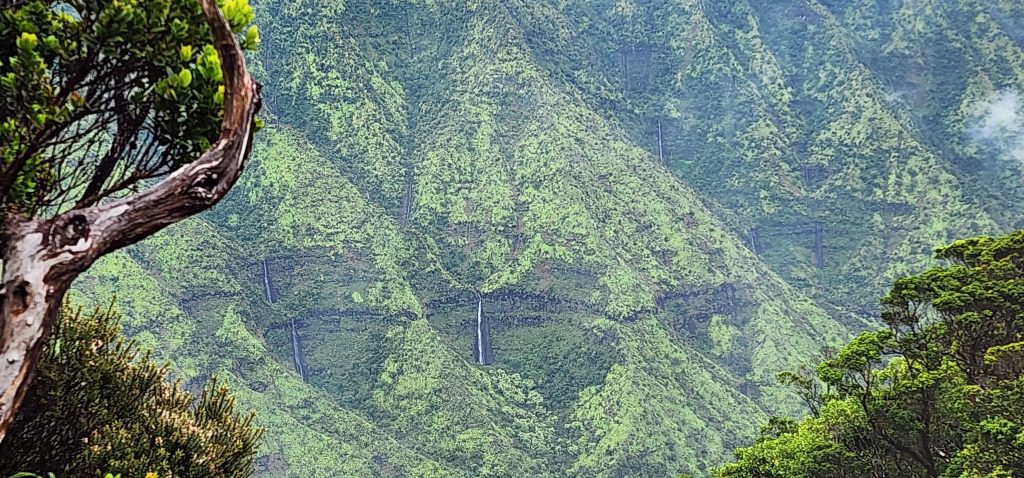07/12/23 – ONLY FIVE ‘AKIKIKI LEFT IN THE MOUNTAINS OF KAUA‘I AND THEIR CHANCES OF SURVIVAL ARE SLIM
Posted on Jul 13, 2023 in Forestry & Wildlife, Main, News Releases, slider| JOSH GREEN, M.D. GOVERNOR |
DAWN CHANG
CHAIRPERSON |
For Immediate Release: July 12, 2023
ONLY FIVE ‘AKIKIKI LEFT IN THE MOUNTAINS OF KAUA‘I AND THEIR CHANCES OF SURVIVAL ARE SLIM
To view video please click on photo or view at this link: https://vimeo.com/844679989
(LĪHUʻE, KAUA‘I) – Only five of the native Hawaiian honeycreeper species, ‘akikiki, are left in the wild and chances of saving them are growing increasingly dire by the day. This frightening revelation was shared by Justin Hite of the Kaua‘i Forest Bird Recovery Project (KFBRP) during a community open house Tuesday evening.
“We have suspended any attempts at bringing the last five of these birds into safety, as they are molting currently and capturing them is too stressful and would likely lead to their demise,” Hite, KFBRP’s field supervisor explained.
Efforts to collect unhatched eggs from tiny nests high in the forest canopy have been much more successful, as eleven of twelve eggs hatched, and baby chicks are now in bird conservation centers on Kaua‘i and Maui, managed by the San Diego Zoo Wildlife Alliance. They’ve joined other ‘akikiki who will be raised in safe keeping until the threat of avian malaria is eliminated in the wild. For Hite, and dozens of others working to save three species of honeycreepers from sure extinction, it’s a foregone conclusion, but depressing, nonetheless.
The ray of hope is the planned implementation of what is known as IIT, or incompatible insect technique. During Tuesday’s open house to provide information and gather input for an Environmental Assessment for the Kauaʻi IIT project, DLNR Division of Forestry and Wildlife (DOFAW) Administrator David Smith detailed the project, pending regulatory approvals, proposed to begin this fall on Kaua‘i.
“We have about three species that are just critical at this point. They’re right on the verge of extinction. Literally, some of these species like ʻakikiki and ‘akeke’e’ on Kaua‘i and kiwikiu on Maui could go extinct within months. They’re just falling out of the sky. They’ve reached the end of the slippery slope they’ve been on for decades. With temperatures increasing and the mosquitos getting further up into the mountains and bringing the deadly avian malaria with them, they’re just decimating these populations.”
IIT involves releasing incompatible male mosquitoes that have a strain of a naturally occurring bacteria (Wolbachia) that is different than the strain in female mosquitoes, which results in female mosquitoes not having viable eggs and offspring. “We’re just going in and putting in an incompatible strain,” Smith said.
He added, “Mosquitos aren’t native here. They don’t provide any crucial ecological role. By suppressing mosquitos, we have a huge environmental positive upside and almost no downside. It’s essentially environmentally benign. In fact, it could help human health issues as well.”
Smith doesn’t dismiss opponents of the IIT project who are seeking a preliminary injunction and temporary restraining order (TRO) to halt the effort. “These people mean well, and they want to protect the environment, but they are misinformed and putting the fate of up to 17 species of Hawaiian honeycreepers in peril. This is not GMO (genetically modified organisms), and while this would be the first wide-scale conservation use of IIT, it has been used safely and successfully around the world for over 50 years to reduce mosquito populations causing diseases in people.” A hearing on the preliminary injunction and TRO is scheduled in O‘ahu Circuit Court on July 21.
While predation and habitat loss have contributed to the extinction of other native bird species, it is avian malaria that has been killing birds in recent years, as mosquitoes move higher into the mountain habitats of the birds, to escape warmer temperatures.
The open house included a series of highly visual displays and the most poignant was one set up by KFBRP that shows honeycreepers as the gems of Hawai‘i’s native forests, along with photos of numerous forest birds that have already gone extinct.
Homage to the birds also included a performance by the halau from Kaʻimi Naʻauao o Hawaiʻi Nei Institute singling out the four honeycreeper species closest to extinction:‘akikiki, akekeʻe, ʻākohekohe, and kiwikiu.
Smith concluded, “There’s a lot of broad-based support for this program. These birds are very charismatic. They’re very emblematic of the native ecosystems here in Hawaiʻi. They dwell in the Wao Akua, the Realm of the Gods. That’s where they are found and they’re really an important part of our native biodiversity. I think people really understand that and have an affinity for them, and they understand that what we’re trying to do is really important.”
# # #
RESOURCES
(All images and video courtesy: DLNR)
HD video – Community Open House on IIT Environmental Assessment (July 11, 2023):
HD video – Ka’imi Na’auao o Hawai’i Nei Institute performance (July 11, 2023):
HD video – “Saving ‘Akikiki-The Field Team Presses On (web feature):
Photographs – Community Open House on IIT Environmental Assessment (July 11, 2023):
https://www.dropbox.com/sh/6ethygi2st3h0fo/AADTaDqxXbHbHlCQTDYcEAgFa?dl=0
Photographs – ‘Akikiki egg collection field work (May 10-12, 2023):
https://www.dropbox.com/sh/ub9d8rq35b1zu4z/AACSUGGUfBdknMOC_iK9ea8Aa?dl=0
Media Contact:
Dan Dennison
Senior Communications Manager
